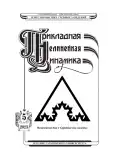Oscillatory characteristics in the brain activity of the newborns and their correlation with different gestational ages
- Authors: Zhuravlev M.O.1, Akimova A.S.1, Panina O.S.2, Kiselev A.R.3
-
Affiliations:
- Saratov State University
- Saratov State Medical University named after V. I. Razumovsky
- Saratov research Institute of Cardiology
- Issue: Vol 31, No 5 (2023)
- Pages: 650-660
- Section: Articles
- URL: https://journals.rcsi.science/0869-6632/article/view/251296
- DOI: https://doi.org/10.18500/0869-6632-003063
- EDN: https://elibrary.ru/SOMZPJ
- ID: 251296
Cite item
Full Text
Abstract
About the authors
Maksim Olegovich Zhuravlev
Saratov State Universityul. Astrakhanskaya, 83, Saratov, 410012, Russia
Alesia Sergeevna Akimova
Saratov State Universityul. Astrakhanskaya, 83, Saratov, 410012, Russia
Olga Sergeevna Panina
Saratov State Medical University named after V. I. Razumovsky
ORCID iD: 0000-0003-3387-4321
410012, Saratov, ul. Bolshaya Kazachya, 112 Telephone: (845-2) -27-33-70, (845-2) -51-15-32 Fax: (845-2) -51-15-34 Website: www.sgmu.ru Electronic mail: meduniv@sgmu.ru
Anton Robertovich Kiselev
Saratov research Institute of Cardiology
ORCID iD: 0000-0003-3967-3950
410028, Saratov, Chernyshevskogo str., 141
References
- Massimini M., Huber R., Ferrarelli F., Hill S., Tononi G. The sleep slow oscillation as a traveling wave // J. Neurosci. 2004. Vol. 24, no. 31. P. 6862–6870. doi: 10.1523/JNEUROSCI.1318- 04.2004.
- Габдракипова А. А., Черватюк М. И., Мищенко А. Н. Сон как маркер здоровья // European Research. 2017. № 7(30). С. 69–71.
- Loddo G., Calandra-Buonaura G., Sambati L., Giannini G., Cecere A., Cortelli P., Provini F. The treatment of sleep disorders in Parkinson’s disease: From research to clinical practice // Front. Neurol. 2017. Vol. 8. P. 42. doi: 10.3389/fneur.2017.00042.
- Stevenson N. J., Oberdorfer L., Koolen N., O’Toole J. M., Werther T., Klebermass-Schrehof K., Vanhatalo S. Functional maturation in preterm infants measured by serial recording of cortical activity // Sci. Rep. 2017. Vol. 7, no. 1. P. 12969. doi: 10.1038/s41598-017-13537-3.
- O’Toole J. M., Boylan G. B., Vanhatalo S., Stevenson N. J. Estimating functional brain maturity in very and extremely preterm neonates using automated analysis of the electroencephalogram // Clin. Neurophysiol. 2016. Vol. 127, no. 8. P. 2910–2918. doi: 10.1016/j.clinph.2016.02.024.
- Koolen N., Oberdorfer L., Rona Z., Giordano V., Werther T., Klebermass-Schrehof K., Stevenson N., Vanhatalo S. Automated classification of neonatal sleep states using EEG // Clin. Neurophysiol. 2017. Vol. 128, no. 6. P. 1100–1108. doi: 10.1016/j.clinph.2017.02.025.
- Pillay K., Dereymaeker A., Jansen K., Naulaers G., Van Huffel S., De Vos M. Automated EEG sleep staging in the term-age baby using a generative modelling approach // J. Neural Eng. 2018. Vol. 15, no. 3. P. 036004. doi: 10.1088/1741-2552/aaab73.
- Kiselev A. R., Drapkina O. M., Novikov M. Y., Panina O. S., Chernenkov Y. V., Zhuravlev M. O., Runnova A. E. Examining time-frequency mechanisms of full-fledged deep sleep development in newborns of different gestational age in the first days of their postnatal development // Sci. Rep. 2022. Vol. 12, no. 1. P. 21593. doi: 10.1038/s41598-022-26111-3.
- Heraghty J. L., Hilliard T. N., Henderson A. J., Fleming P. J. The physiology of sleep in infants // Arch. Dis. Child. 2008. Vol. 93, no. 11. P. 982–985. doi: 10.1136/adc.2006.113290.
- Scher M. S., Loparo K. A. Neonatal EEG/sleep state analyses: a complex phenotype of developmental neural plasticity // Dev. Neurosci. 2009. Vol. 31, no. 4. P. 259–275. doi: 10.1159/000216537.
- Villa M. P., Calcagnini G., Pagani J., Paggi B., Massa F., Ronchetti R. Effects of sleep stage and age on short-term heart rate variability during sleep in healthy infants and children // Chest. 2000. Vol. 117, no. 2. P. 460–466. doi: 10.1378/chest.117.2.460.
- Anders T. F., Keener M. A., Kraemer H. Sleep-wake state organization, neonatal assessment and development in premature infants during the first year of life. II // Sleep. 1985. Vol. 8, no. 3. P. 193–206. doi: 10.1093/sleep/8.3.193.
- Runnova A., Zhuravlev M., Ukolov R., Blokhina I., Dubrovski A., Lezhnev N., Sitnikova E., Saranceva E., Kiselev A., Karavaev A., Selskii A., Semyachkina-Glushkovskaya O., Penzel T., Jurgen Kurths J. Modified wavelet analysis of ECoG-pattern as promising tool for detection of the blood–brain barrier leakage // Sci. Rep. 2021. Vol. 11, no. 1. P. 18505. doi: 10.1038/s41598- 021-97427-9.
- Sergeev K., Runnova A., Zhuravlev M., Kolokolov O., Akimova N., Kiselev A., Titova A., Slepnev A., Semenova N., Penzel T. Wavelet skeletons in sleep EEG-monitoring as biomarkers of early diagnostics of mild cognitive impairment // Chaos. 2021. Vol. 31, no. 7. P. 073110. doi: 10.1063/5.0055441.
- Runnova А. E., Zhuravlev M. O., Pysarchik A. N., Khramova M. V., Grubov V. V. The study of cognitive processes in the brain EEG during the perception of bistable images using wavelet skeleton // In: Proc. SPIE. Vol. 10063. Dynamics and Fluctuations in Biomedical Photonics XIV. 3 March 2017, San Francisco, California, United States. SPIE, 2017. P. 1006319. DOI: 10.1117/ 12.2250403.
- Maksimenko V. A., Runnova A. E., Zhuravlev M. O., Makarov V. V., Nedayvozov V., Grubov V. V., Pchelintceva S. V., Hramov A. E., Pisarchik A. N. Visual perception affected by motivation and alertness controlled by a noninvasive brain-computer interface // PLoS ONE. 2017. Vol. 12, no. 12. P. e0188700. doi: 10.1371/journal.pone.0188700.
- Simonyan M., Fisun A., Afanaseva G., Glushkovskaya-Semyachkina O., Blokhina I., Selskii A., Zhuravlev M., Runnova A. Oscillatory wavelet-patterns in complex data: mutual estimation of frequencies and energy dynamics // Eur. Phys. J. Spec. Top. 2023. Vol. 232, no. 5. P. 595–603. doi: 10.1140/epjs/s11734-022-00737-w.
Supplementary files










